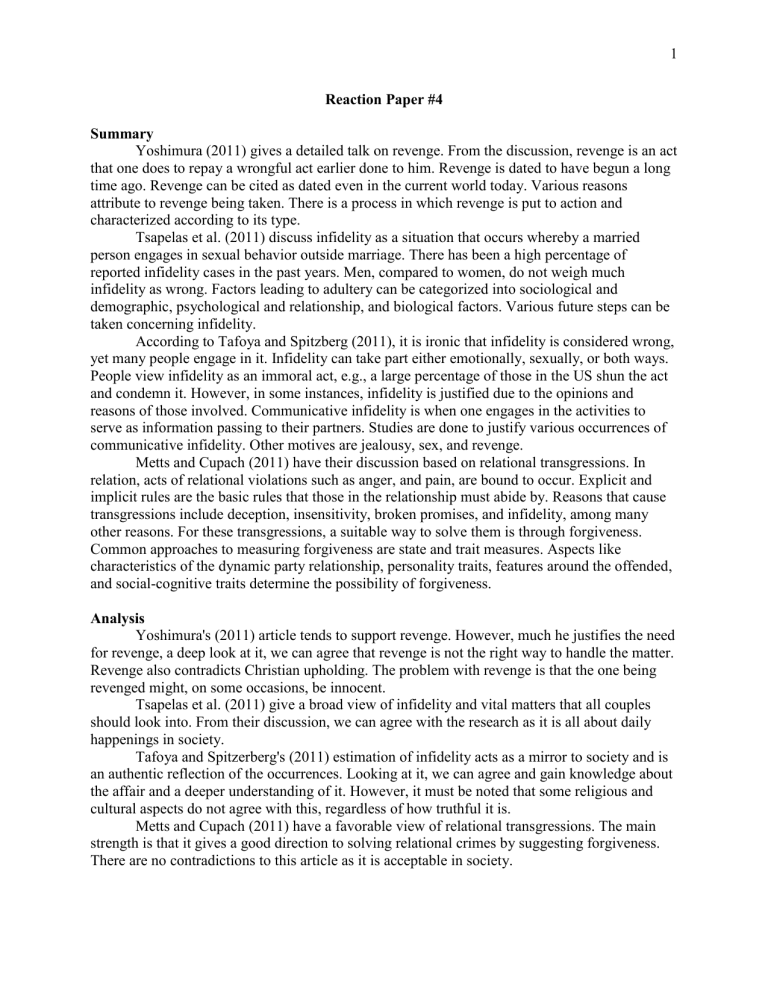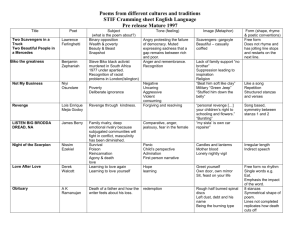
1 Reaction Paper #4 Summary Yoshimura (2011) gives a detailed talk on revenge. From the discussion, revenge is an act that one does to repay a wrongful act earlier done to him. Revenge is dated to have begun a long time ago. Revenge can be cited as dated even in the current world today. Various reasons attribute to revenge being taken. There is a process in which revenge is put to action and characterized according to its type. Tsapelas et al. (2011) discuss infidelity as a situation that occurs whereby a married person engages in sexual behavior outside marriage. There has been a high percentage of reported infidelity cases in the past years. Men, compared to women, do not weigh much infidelity as wrong. Factors leading to adultery can be categorized into sociological and demographic, psychological and relationship, and biological factors. Various future steps can be taken concerning infidelity. According to Tafoya and Spitzberg (2011), it is ironic that infidelity is considered wrong, yet many people engage in it. Infidelity can take part either emotionally, sexually, or both ways. People view infidelity as an immoral act, e.g., a large percentage of those in the US shun the act and condemn it. However, in some instances, infidelity is justified due to the opinions and reasons of those involved. Communicative infidelity is when one engages in the activities to serve as information passing to their partners. Studies are done to justify various occurrences of communicative infidelity. Other motives are jealousy, sex, and revenge. Metts and Cupach (2011) have their discussion based on relational transgressions. In relation, acts of relational violations such as anger, and pain, are bound to occur. Explicit and implicit rules are the basic rules that those in the relationship must abide by. Reasons that cause transgressions include deception, insensitivity, broken promises, and infidelity, among many other reasons. For these transgressions, a suitable way to solve them is through forgiveness. Common approaches to measuring forgiveness are state and trait measures. Aspects like characteristics of the dynamic party relationship, personality traits, features around the offended, and social-cognitive traits determine the possibility of forgiveness. Analysis Yoshimura's (2011) article tends to support revenge. However, much he justifies the need for revenge, a deep look at it, we can agree that revenge is not the right way to handle the matter. Revenge also contradicts Christian upholding. The problem with revenge is that the one being revenged might, on some occasions, be innocent. Tsapelas et al. (2011) give a broad view of infidelity and vital matters that all couples should look into. From their discussion, we can agree with the research as it is all about daily happenings in society. Tafoya and Spitzerberg's (2011) estimation of infidelity acts as a mirror to society and is an authentic reflection of the occurrences. Looking at it, we can agree and gain knowledge about the affair and a deeper understanding of it. However, it must be noted that some religious and cultural aspects do not agree with this, regardless of how truthful it is. Metts and Cupach (2011) have a favorable view of relational transgressions. The main strength is that it gives a good direction to solving relational crimes by suggesting forgiveness. There are no contradictions to this article as it is acceptable in society. 2 Synthesis A Look at these articles; shows a significant relationship between them as they talk of the essential societal occurrences. The readings relate to each other in the way that one can result in another, and they all involve relationship issues. Yoshimura's (2011) article on revenge justifies actions that may lead one to act through revenge. However, it is not a wise step, especially when one is unsure if the action took place. Tsapelas et al. (2011) enable us to better understand infidelity and how best we can address this issue. Through his analysis, we can also come up with ways to reduce infidelity. By analyzing infidelity, Tafoya and Spitzerberg (2011) give us an estimation of the rate of infidelity. Looking at all the assessments, we can know how infidelity is a significant issue in the world. Finally, Metts and Cupach (2011) look at relational transgressions and recommend forgiving as a solution to them. By this article, we are rightfully given a good solution to relationship issues. Using forgiveness is a peaceful method to solve a problem in a relationship unlike revenge. Discussion questions 1. Does forgiving one solve relational transgression is it just a way that one is forced to let hurtful doings go unpaid for? 2. How effective is revenge in infidelity cases compared to forgiveness putting to consideration that the mistake once done can be repeated? References Metts, S., & Cupach, W. R. (2011). Responses to relational transgressions: Hurt, anger, and sometimes forgiveness. In B. H. Spitzberg & W. R. Cupach (Eds.), The dark side of interpersonal communication (2nd ed., pp. 243-274). Routledge. Tafoya, M. A. & Spitzberg, B. H. (2011). The dark side of infidelity: Its nature, prevalence, and communicative functions. In B. H. Spitzberg & W. R. Cupach (Eds.), The dark side of interpersonal communication (2nd ed., pp. 201-242). Routledge. Tsapelas, I., Fisher, H. E., & Aron, A. (2011). Infidelity: When, where, why. In W. R. Cupach & B. H. Spitzberg (Eds.), The dark side of close relationships II (2nd ed., pp. 175-195). Routledge. Yoshimura, S. (2011). The communication of revenge: On the viciousness, virtues, and vitality of vengeful behavior in interpersonal relationships. . In B. H. Spitzberg & W. R. Cupach (Eds.), The dark side of interpersonal communication (2nd ed., pp. 277-296). Routledge.





